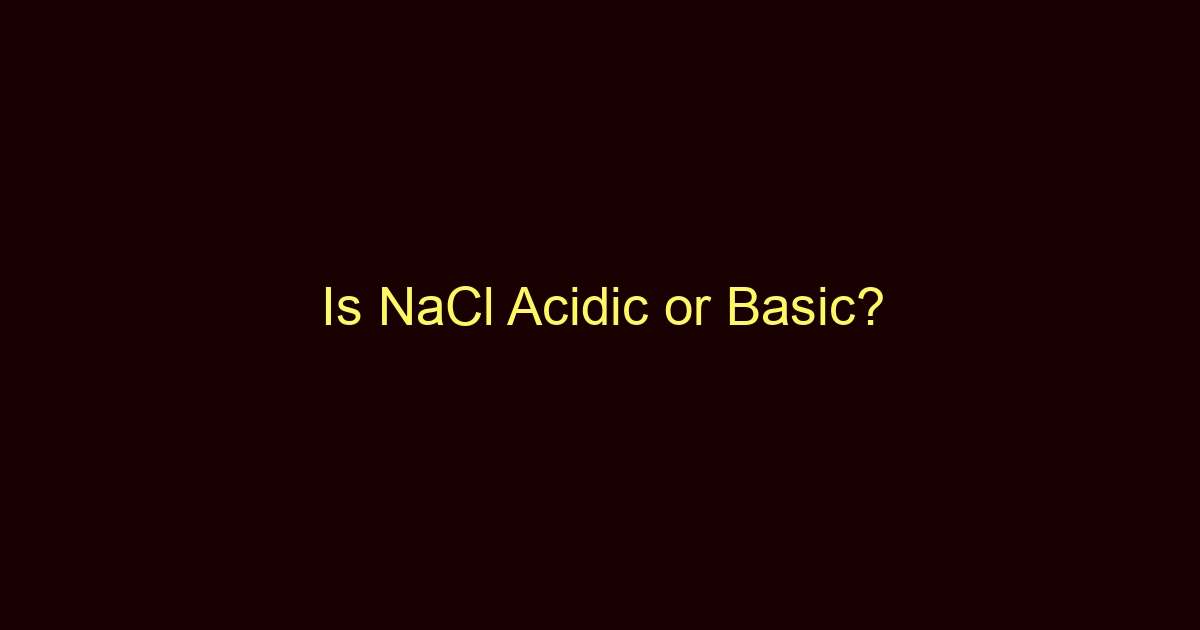Sodium chloride, commonly known as table salt or simply NaCl, is neither acidic nor alkaline. It is a neutral compound, and when dissolved in water, it yields a solution with a pH close to 7.
NaCl, or sodium chloride, is one of the most ubiquitous compounds on Earth. Primarily known as table salt, it’s a staple in households and industries alike. One question that often comes up is about its acidic or alkaline nature. Is it going to turn your neutral water acidic or basic when dissolved? It’s a question with implications ranging from culinary uses to scientific applications. In this article, we’re diving deep into the pH properties of NaCl to dispel myths and give you the scientific lowdown.
Is NaCl Acidic?
No, NaCl is not acidic. When NaCl is dissolved in water, it disassociates into sodium (Na+) and chloride (Cl-) ions. Neither of these ions reacts to form hydrogen ions (H+), which would be the requirement for the solution to be acidic.
Sodium chloride is a classic example of a neutral salt. Even if you remember your high school chemistry, you’d know that salts are often the end products of a reaction between an acid and a base. In the case of NaCl, it’s the result of hydrochloric acid (HCl) reacting with sodium hydroxide (NaOH).
Sodium chloride has a wide range of applications, from seasoning food to use in various industrial processes. Its neutrality is often an advantage, as it doesn’t interfere with the pH levels of solutions it’s added to. For instance, NaCl enhances flavor in cooking without making the dish acidic or alkaline. In industries like textiles and paper, it’s used as a neutral substance that doesn’t interfere with chemical reactions.
Is NaCl Basic?
No, NaCl is not basic. If you dissolve NaCl in water, you won’t find hydroxide ions (OH-) being formed, which is the condition for a solution to be basic. Just like we discussed in the acidic section, NaCl disassociates into Na+ and Cl- ions. These ions don’t engage in reactions that would change the pH level to make it basic. In other words, adding sodium chloride to a neutral solution like water will not tilt the pH scale towards the alkaline end.
In many lab settings, the neutral pH of a NaCl solution is actually desired. For example, sodium chloride solutions in biology labs are commonly used to maintain cells in a stable environment. Similarly, chemistry labs often employ it as a neutral medium for various experiments. Its lack of basicity is often a boon rather than a downside.
pH Values of NaCl:
NaCl typically results in a solution with a pH close to 7 when dissolved in water. This is the pH of pure water, indicating neutrality. Unless there are impurities or other substances mixed in, a sodium chloride solution should not significantly alter the pH level of water. It’s worth noting that the concentration of NaCl in the solution also plays a minor role, although the pH will generally remain close to neutral.
Final Thoughts
So there you have it, folks. NaCl is neither acidic nor basic; it’s a neutral compound. This neutrality is one of the reasons it is so widely used across various sectors. From adding that extra zing to your fries to stabilizing cells in a culture medium, its impact is neutral, literally and chemically.
When it comes to pH, NaCl is as middle-of-the-road as it gets; sometimes, that’s exactly what you need. Whether in the kitchen, in the lab, or in industrial processes, the neutrality of NaCl often makes it the go-to choice.

